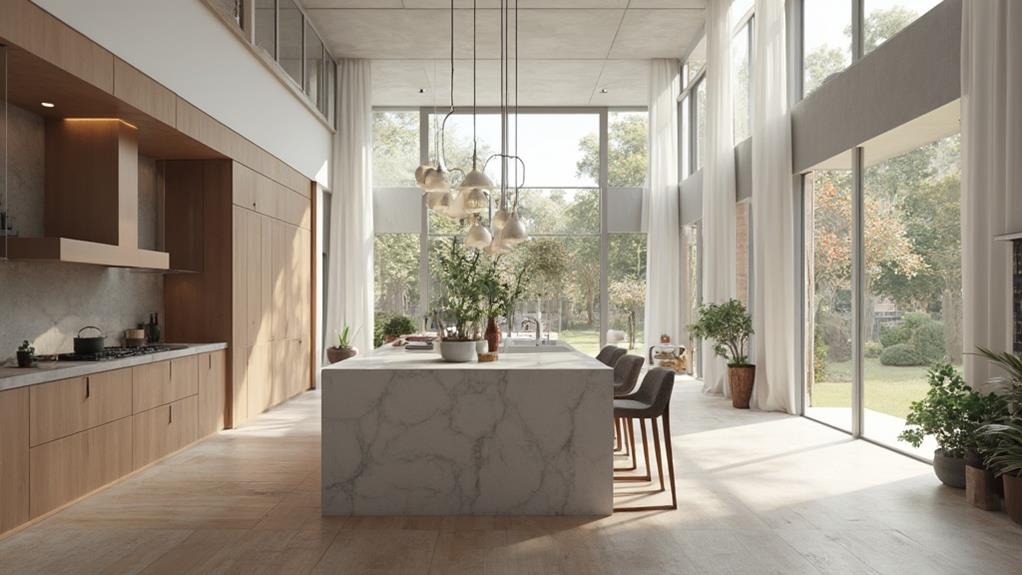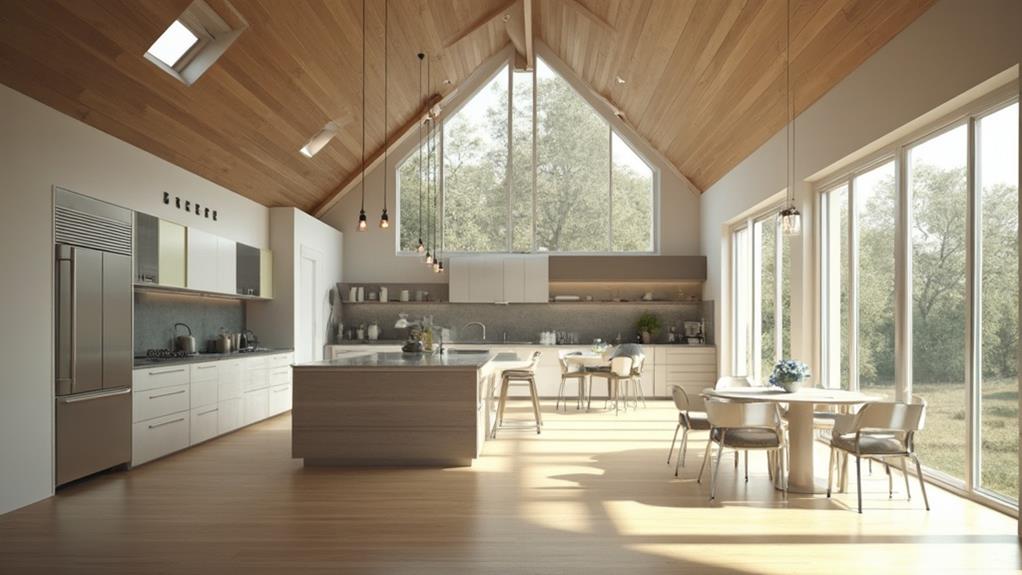Ceiling height significantly impacts your kitchen's design and functionality. Higher ceilings create a spacious feel, allowing for taller cabinets and more storage options. They also provide better air circulation and natural light distribution. Lower ceilings, while cozier, require creative solutions to maximize space. Lighting choices vary based on height, with high ceilings offering more options for pendant lights and chandeliers. Ventilation systems and air quality are also affected by ceiling height. Psychologically, higher ceilings can boost creativity, while lower ones enhance focus on detailed tasks. By understanding these impacts, you'll be better equipped to make informed decisions about your kitchen's layout and design elements.
Functionality and Space Perception

Ceilings play a crucial role in shaping your kitchen's functionality and how spacious it feels. Higher ceilings can create an illusion of more space, making your kitchen appear larger and more open. This increased vertical space allows for better air circulation and natural light distribution, enhancing the overall ambiance of the room.
With taller ceilings, you'll have more options for storage and design elements. You can install upper cabinets that reach closer to the ceiling, maximizing storage capacity without cluttering the space. Pendant lights, chandeliers, or decorative exhaust hoods can become striking focal points, adding visual interest and personality to your kitchen.
However, lower ceilings aren't without their advantages. They can create a cozier, more intimate atmosphere, which some homeowners prefer. Lower ceilings also make it easier to reach upper cabinets and maintain light fixtures. They're often more energy-efficient, as there's less space to heat or cool.
When designing your kitchen, consider how ceiling height affects task lighting, ventilation, and the placement of appliances. Ultimately, the ideal ceiling height depends on your personal preferences, cooking habits, and the overall style you want to achieve in your kitchen.
Cabinetry and Storage Options
Building on the impact of ceiling height, let's explore how it influences your cabinetry and storage options. In kitchens with high ceilings, you'll have the luxury of extending your cabinets vertically, maximizing storage space. You can opt for taller upper cabinets or even double-stacked cabinets to utilize the full height. This allows you to store less frequently used items in the uppermost cabinets while keeping everyday essentials within easy reach.
For rooms with lower ceilings, you'll need to focus on maximizing horizontal space. Consider using full-extension drawers and pull-out organizers to make the most of your base cabinets. Wall-mounted shelves or hanging pot racks can help free up cabinet space without overwhelming the room.
Regardless of ceiling height, you can incorporate clever storage solutions like corner lazy Susans, built-in spice racks, or hidden pantry pull-outs. If you have high ceilings, don't forget to include a step stool or rolling ladder for easy access to upper storage. For lower ceilings, under-cabinet lighting can help brighten the space and make it feel more open while illuminating your work areas.
Lighting Considerations

Illumination plays a crucial role in kitchen design, and ceiling height significantly impacts your lighting choices. In kitchens with high ceilings, you'll have more options for layered lighting. You can install pendant lights or chandeliers to create a focal point and provide task lighting over islands or dining areas. These fixtures can also add visual interest and help fill the vertical space.
For lower ceilings, you'll need to be more strategic. Opt for flush-mount or semi-flush fixtures to maximize headroom. Recessed lighting is an excellent choice for both high and low ceilings, providing even illumination without taking up space. In kitchens with standard-height ceilings, under-cabinet lighting becomes crucial for task areas.
Regardless of ceiling height, consider incorporating dimmers to adjust light levels throughout the day. For high ceilings, you might need additional wall sconces or track lighting to ensure proper illumination at countertop level. In contrast, low-ceiling kitchens benefit from bouncing light off walls and using light-colored surfaces to create a sense of openness. Always factor in natural light sources when planning your kitchen's lighting scheme, as windows and skylights can greatly influence the overall brightness of the space.
Ventilation and Air Quality
While lighting enhances the visual appeal of your kitchen, proper ventilation ensures a healthy and comfortable cooking environment. Ceiling height plays a crucial role in determining the effectiveness of your kitchen's ventilation system. Higher ceilings allow for more efficient air circulation, reducing the accumulation of cooking odors, smoke, and grease particles.
In kitchens with high ceilings, you'll have more options for installing powerful range hoods and exhaust fans. These can be mounted higher above the cooking surface, providing better coverage and capturing airborne contaminants more effectively. You'll also have space for larger, more efficient units that can handle higher air volumes.
For lower ceilings, you'll need to be more creative with your ventilation solutions. Consider downdraft systems or under-cabinet range hoods to maximize space. Alternatively, you can opt for ceiling-mounted fans or recirculating hoods that don't require external venting.
Regardless of ceiling height, ensure your ventilation system is properly sized for your kitchen's dimensions and cooking habits. Don't forget to incorporate fresh air intake sources, such as windows or dedicated vents, to maintain optimal air quality and prevent negative air pressure issues.
Psychological Effects

Beyond functional considerations, ceiling height can significantly impact the psychological atmosphere of your kitchen. Higher ceilings create a sense of openness and spaciousness, which can make you feel more relaxed and less confined while cooking or entertaining. This increased vertical space can also boost your creativity and abstract thinking, potentially inspiring culinary experimentation.
Conversely, lower ceilings may foster a cozier, more intimate environment. You'll likely feel a stronger connection to the space and its contents, which can enhance your focus on detailed tasks. This can be particularly beneficial for precision cooking techniques.
The perceived temperature of your kitchen is also affected by ceiling height. Higher ceilings can make the room feel cooler, while lower ceilings create a warmer ambiance. This psychological effect can influence your comfort level and the amount of time you're willing to spend in the kitchen.
Ceiling height also impacts your perception of time. In higher-ceilinged kitchens, you might feel less rushed and more inclined to linger, promoting social interactions. Lower ceilings, however, can create a sense of urgency, potentially increasing efficiency for quick meal preparations.
Design Solutions for Various Heights
Every kitchen can benefit from tailored design solutions that maximize its ceiling height. For low ceilings (under 8 feet), you'll want to create an illusion of space. Use light colors on walls and cabinets, and opt for glossy finishes to reflect light. Install recessed lighting instead of hanging fixtures, and choose sleek, low-profile appliances. Consider open shelving or glass-front cabinets to reduce visual weight.
If you're working with standard 8-9 foot ceilings, you've got more flexibility. You can incorporate pendant lights over islands or dining areas. Use a mix of upper and lower cabinets, and don't shy away from vertical storage solutions.
For ceilings 10 feet and above, you've got room to make a statement. Install taller upper cabinets or add a second row of cabinets above the standard height. Use dramatic lighting fixtures or create a coffered ceiling for added interest.
Regardless of height, vertical lines can enhance the perception of space. Use floor-to-ceiling cabinets, tall backsplashes, or vertical paneling to draw the eye upward. Remember, the key is to work with your ceiling height, not against it.
Conclusion
You've seen how ceiling height profoundly impacts your kitchen's design and feel. From storage to lighting, every aspect is affected. Remember, studies show that higher ceilings (10 feet or more) can increase a sense of freedom by up to 50% compared to standard 8-foot ceilings. Whether you're dealing with soaring heights or cozy spaces, there are creative solutions to maximize functionality and ambiance. Embrace your kitchen's unique dimensions and design accordingly.

